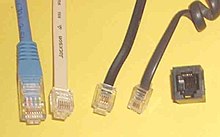
Back RJ-telefoonprop Afrikaans مقبس مسجل Arabic Registered jack Catalan RJ-Steckverbindung German Registered jack Spanish RJ-pistikühendus Estonian Registered jack Basque جک ثبتشده Persian Registered jack French Registered jack Japanese

- Eight-position, eight-contact (8P8C) plug, as used for RJ45S, RJ49, RJ61, and others (though shown wired in a pattern incompatible with RJ61)
- Six-position, six-contact (6P6C) plug, which can be used with RJ25, RJ14, and RJ11
- Six-position, four-contact (6P4C) plug, which can be used with RJ14 and RJ11 (and will carry lines 1 and 2, but not line 3, of an RJ25)
- Four-position, four-contact (4P4C) plug, used for connecting a telephone handset and base
- Six-position, six-contact (6P6C) jack, which could be wired as RJ11, RJ14, or RJ25
A registered jack (RJ) is a standardized telecommunication network interface for connecting voice and data equipment to a computer service provided by a local exchange carrier or long distance carrier. Registered interfaces were first defined in the Universal Service Ordering Code (USOC) system of the Bell System in the United States for complying with the registration program for customer-supplied telephone equipment mandated by the Federal Communications Commission (FCC) in the 1970s.[1] They were subsequently codified in title 47 of the Code of Federal Regulations Part 68.[2][3][4] Registered jack connections began to see use after their invention in 1973 by Bell Labs.[5] The specification includes physical construction, wiring, and signal semantics. Accordingly, registered jacks are primarily named by the letters RJ, followed by two digits that express the type. Additional letter suffixes indicate minor variations. For example, RJ11, RJ14, and RJ25 are the most commonly used interfaces for telephone connections for one-, two-, and three-line service, respectively. Although these standards are legal definitions in the United States, some interfaces are used worldwide.
The connectors used for registered jack installations are primarily the modular connector and the 50-pin miniature ribbon connector. For example, RJ11 and RJ14 use female six-position modular connectors, and RJ21 uses a 25-pair (50-pin) miniature ribbon connector. RJ11 uses two conductors in a six-position female modular connector, so can be made with any female six-position modular connector, while RJ14 uses four, so can be made with either a 6P4C or a 6P6C connector.
- ^ AT&T, Registration Interface—Selection and General Information, Bell System Practices, Section 463-400-100 Issue 1, May 1976
- ^ Cite error: The named reference
FCC47Part68was invoked but never defined (see the help page). - ^ Cite error: The named reference
T1.TR5-1999was invoked but never defined (see the help page). - ^ Cite error: The named reference
ACTAdocswas invoked but never defined (see the help page). - ^ "RJ-11 Definition". Retrieved 24 June 2020.